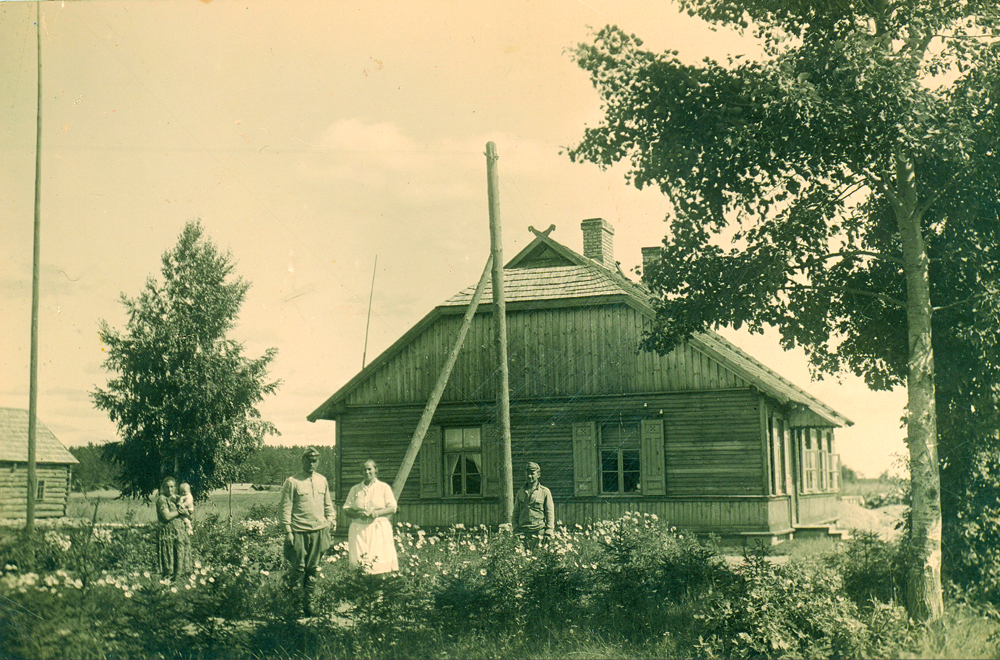
From 1935 to 1940, under the leadership of Colonel Ludvigs Bolšteins – an outstanding commander and patriotic leader – the Latvian Border Guard experienced a true period of flourishing. New buildings were constructed for border guards and their families, solid and beautifully furnished homes often surrounded by gardens and nurseries.
During Bolšteins’s leadership, border guards actively participated in the cultural and sports life of local communities. They organized events, built stadiums, and even established schools. The professionalism and quality of the border guard service reached new heights. Cultural activities included the construction of community centers, which had electric lighting, halls with film projectors and pianos.
In Krivanda, at the site of the former guard post, the original living quarters are no longer standing – they were burned down by partisans. Only the stone staircase and foundation remain from the once magnificent community center, known for its richly painted walls and ceilings. However, several other buildings have survived, including the border guard store, horse stables, and residential houses.
Thanks to the memories of Lidija Kurcenbauma, wife of a border guard Arvīds Kurcenbaums, we can vividly imagine what life was like for border guards in those times: “The border guards lived in harmony with the locals. Many even married local girls. I met Arvīds in 1940, and we married on June 16th. A state of war had already been declared, but Arvīds was granted two hours leave so we could have our wedding in church and sit down for a simple meal. The border guard stations were beautifully maintained – clean, flowerbeds, ornamental shrubs, and solid buildings.
The Krivanda post had a stunning community center with murals, elegant stairs, rose gardens, and greenhouses for seedlings. They grew fruit trees and bushes, as well as vegetable plants like tomatoes, not only for themselves but to share with local farms.
They held Christmas celebrations with decorated trees and candy for children, hosted balls with orchestras that drew guests even from other districts. They built schools and sports fields, staged theatre performances.
The post had cozy homes and a store where you could buy everything – sausages, cheese, dishes, fabrics, clothes. In the stable, well-kept horses were kept for riding, but they also used bicycles and skis in winter.
Home economics courses were offered to border guards’ wives and local women – they learned to cook, bake cakes, and prepare preserves for winter.
Though there were certain restrictions near the border, everyone lived peacefully. The border guards helped a lot and did good work in the region.”
But everything changed on June 15, 1940, when coordinated attacks were launched against Latvian border guard posts – including the tragic attack on the Masļenki post, where soviet secret police troops killed both guards and civilians. The guards and their families were surrounded, and the brutal assault marked the beginning of the end for Latvia’s independence.
The attack on Masļenki was carried out by NKVD operatives who killed guards and civilians alike. Dozens of people, including children, were taken prisoner and forced across the border into the Soviet Union. The guards, positioned by the Ludza River, were encircled, with no chance of escape – telephone lines had been cut. To hide the evidence of their crimes, the attackers set the post buildings on fire. Soon after, similar assaults were launched against other posts.
The Masļenki tragedy became a powerful symbol of Latvia’s loss of freedom and the Soviet Union’s ruthless aggression. It was a messenger of the occupation that officially began the next day, when the USSR issued an ultimatum to Latvia and began a 50-year-long occupation. Colonel Ludvigs Bolšteins – one of Latvia’s most respected Border Guard commanders – met his fate in the shadow of these events. His final letter reflected unwavering loyalty to Latvia: “We Latvians have built a tall, proud building – our own country. A foreign power now demands that we tear it down with our own hands. I cannot take part in that.”
Soon after, on October 3, 1940, Soviet People’s Commissar Alfons Noviks signed an order to disband all four battalions of the Latvian Border Guard Brigade and dismiss the border guards stationed along the eastern frontier…